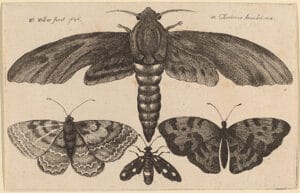RSVP HERE TO RECEIVE THE ZOOM DETAILS: https://marylandnature.wildapricot.org/event-4552132
Suppose a beautiful insect lands on your arm late one afternoon while you’re relaxing outside. You can see six legs and two antennae coming from on its narrow body, and it has four wide, sweeping, green wings with delicate red and yellow accents. If you carefully touch a wing, a little bit of powder comes off on your finger. It’s obvious to you that this insect either a butterfly or a moth — but which is it?
Translated from Greek, Lepidoptera means “scaled wings”. It is the order of insects that includes moths and butterflies. Moths and butterflies share some commonalities and some notable differences. While understanding their morphologies will help you distinguish between the two, nature being nature, some species have taken advantage of these differences and have evolved to look like the other. Join Fred Paras, President – Maryland Entomological Society. Professor – Natural and Physical Sciences department, vice-president Faculty Senate, Baltimore City Community College (BCCC), Baltimore, MD and NHSM Invertebrates Curator, Malacology, to learn what makes a butterfly a butterfly and a moth a moth even when they lookalike.
Fred Paraskevoudakis, President – Maryland Entomological Society. Professor – Natural and Physical Sciences department, vice-president Faculty Senate, Baltimore City Community College (BCCC), Baltimore, MD and NHSM Invertebrates Curator, Malacology. Fred Paras has been teaching primarily Microbiology at BCCC since 1992, but has also taught Environmental Science and Biotechnology courses. He hold two Bachelors from U. of Md., an MS from JHU (Environmental Science) and an MS from Towson (Biology). His passion for insects and natural history began over fifty years ago, and has continually increased throughout his life. He is an ardent traveler, photographer and prodigious collector who has been fortunate to visit many places in the world.
The Lep Club, is made up of novice and expert lepidopterists who meet to exchange knowledge and support concerning habitat, threats, food sources, identification, and life cycle of butterflies and moths. Club meetings encourage a sharing of knowledge for the raising and breeding of moths and butterflies through hands-on lessons and guest speakers. Club members are also involved in outreach in the greater Baltimore community through educational programs and service projects. Club meetings feature a guest speaker that share their knowledge on a topic related to moths and butterflies as well as time to distribute caterpillars and eggs. As a group, we rear and share incredible native butterflies and saturniid moths (lunas, polyphemus, cedropia, imperials and more) with one another. Senior club members always walk you through everything you need to know in order to successfully raise your new friends. The goal is to raise enough leps that some can be released and increase the wild population.
To learn more about all NHSM Clubs: https://youtu.be/pIA7naRjXws
To become a member: https://www.marylandnature.org/club-membership/
RSVP HERE TO RECEIVE THE ZOOM DETAILS: https://marylandnature.wildapricot.org/event-4552132

